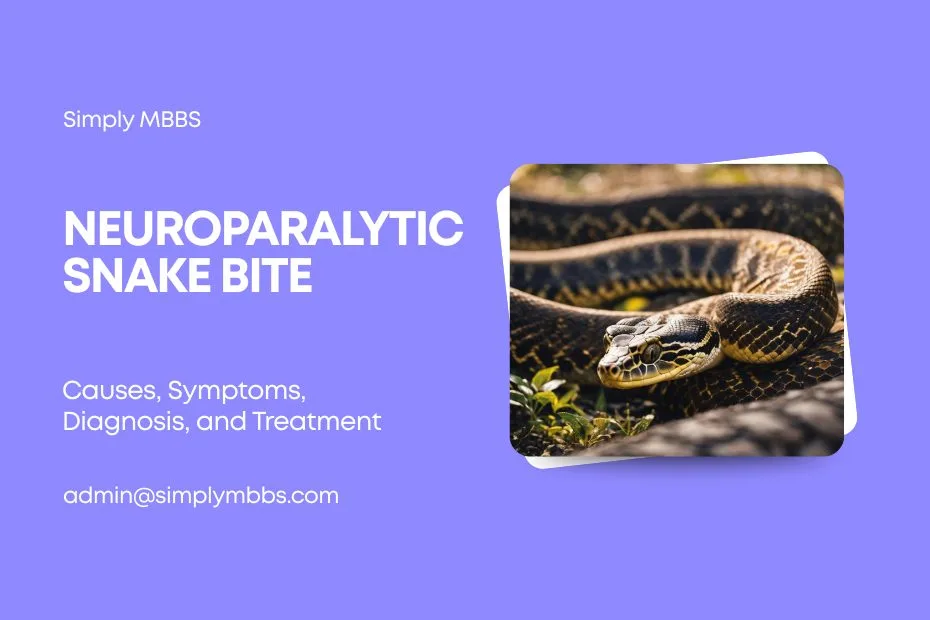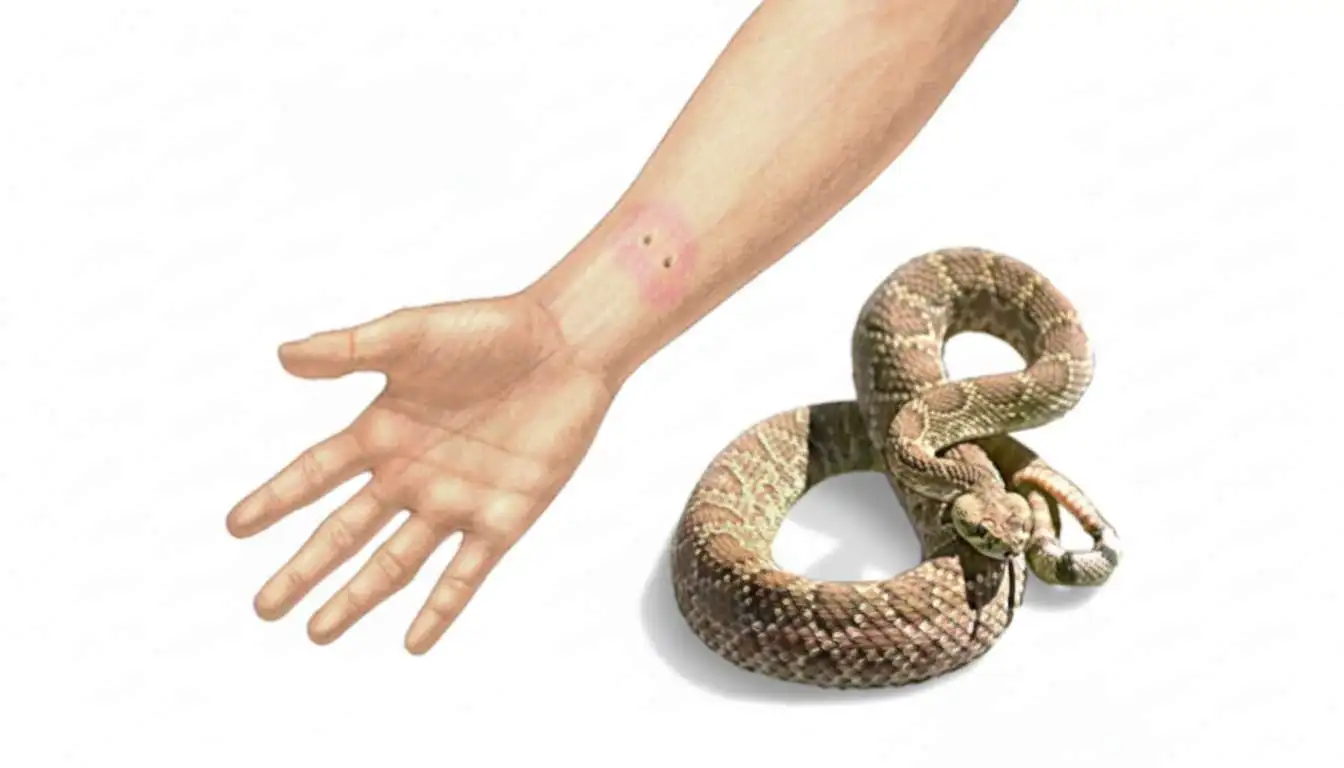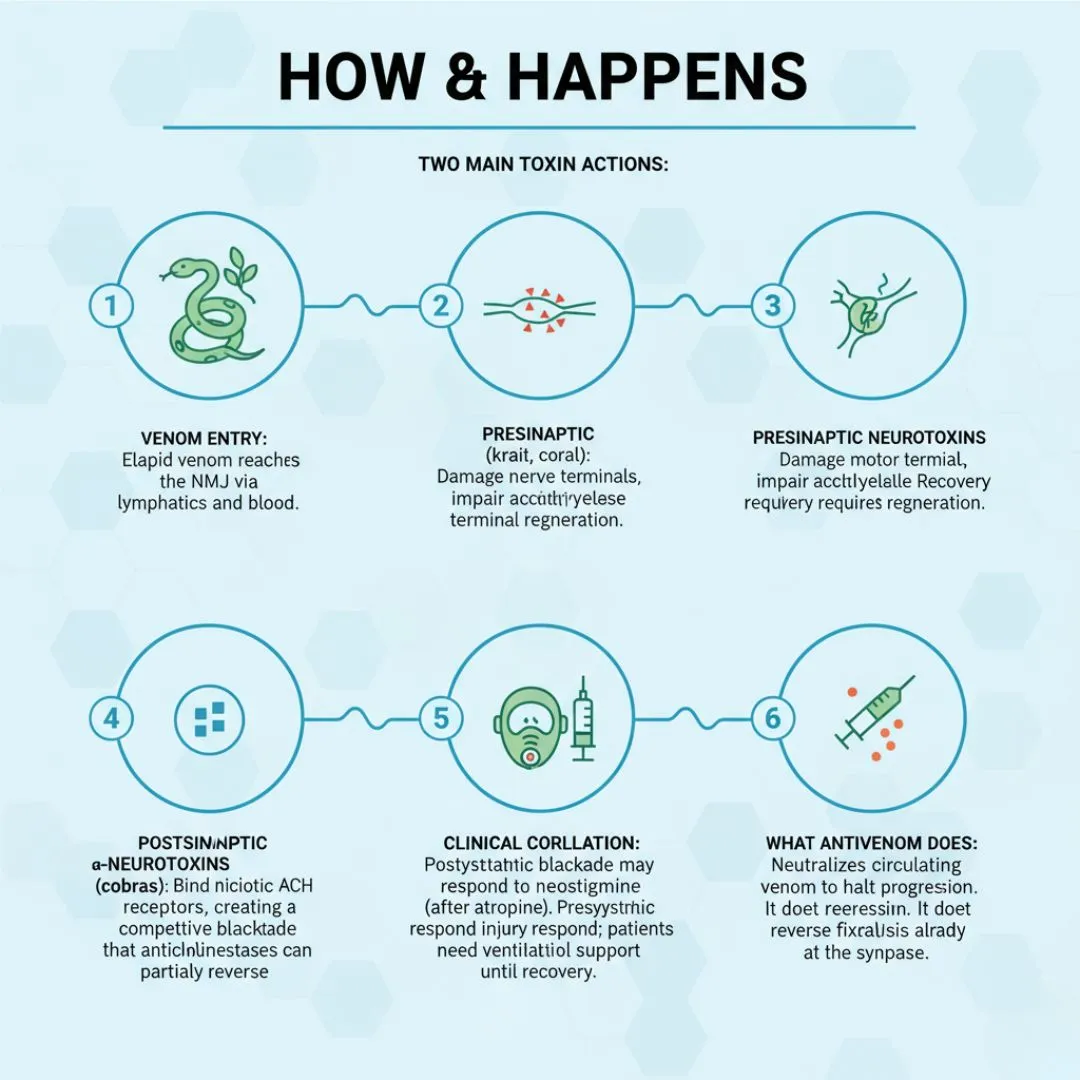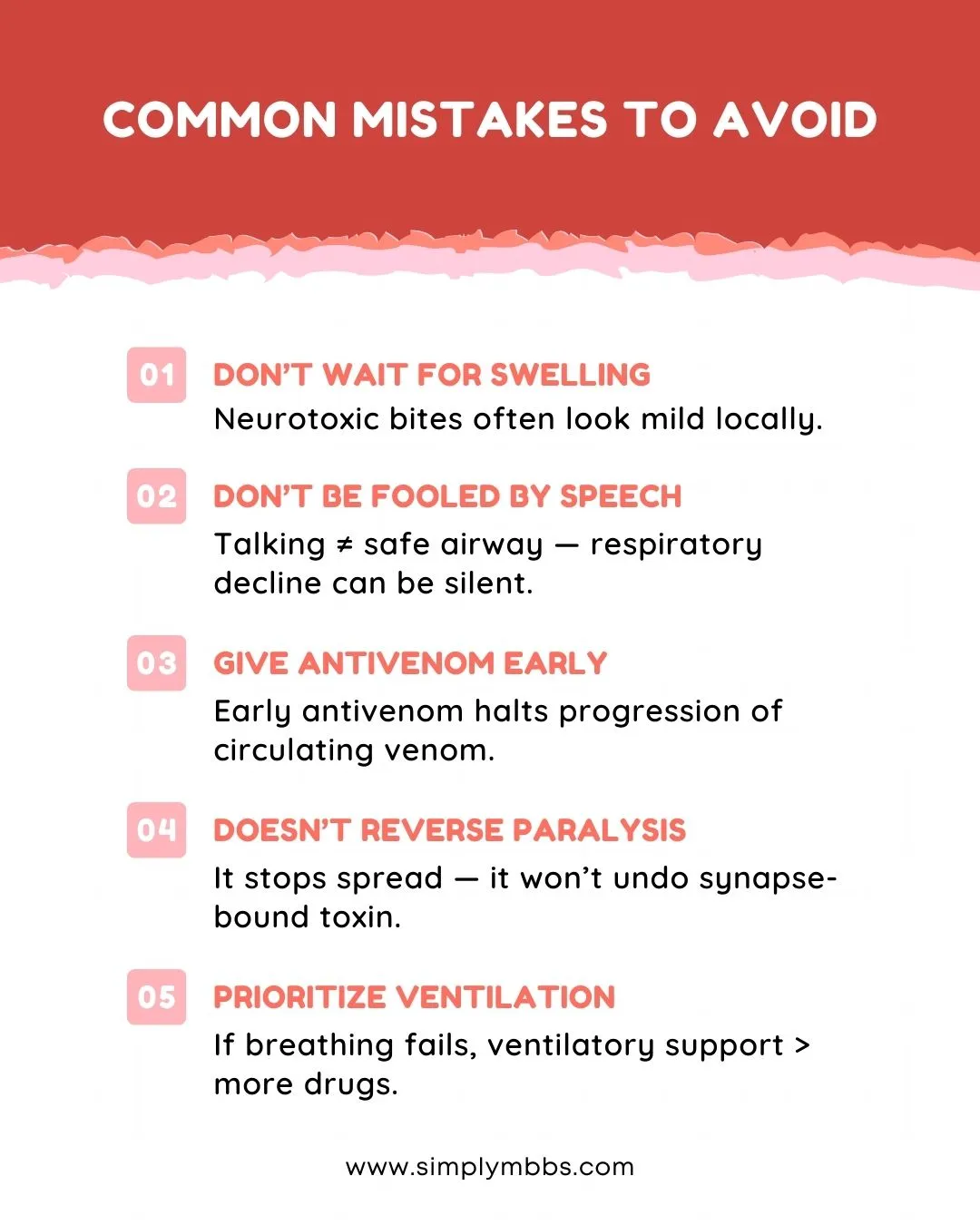You notice drooping eyelids and slurred speech after a bite that barely hurt. Breathing feels heavier. Minutes matter. That snapshot captures neuroparalytic snake bite—a neurotoxic envenoming that blocks signals at the neuromuscular junction and can silence respiratory muscles. In India, cobras and kraits dominate these cases; in the US, coral snakes play the lead. Early recognition, antivenom, and timely airway support save lives. This guide explains neuroparalytic symptoms, the Snake bite treatment protocol, and key differences among cobra, krait, and coral bites. You’ll also find exam-style notes, dosing pearls, and FAQs—written plainly for MBBS students, doctors, and informed readers. With evidence-based care, most patients recover.
What is a Neuroparalytic snake bite?
A Neurotoxic snake bite injects venom that targets the neuromuscular junction (NMJ)—the connection between motor nerves and muscles. Toxins either damage the nerve terminal (presynaptic, common with krait and many coral snakes) or block acetylcholine receptors (postsynaptic α-toxins, common with cobra). Clinically, you see descending paralysis: ptosis → ophthalmoplegia → bulbar weakness → diaphragmatic failure. Antivenom neutralizes circulating venom; ventilatory support buys time while synapses recover.
Why Neuroparalytic snake bite matters
- Rural India: Travel time to care can be long; simple first-aid and early referral change outcomes.
- US South: Coral-snake bites are less common but dangerous; early antivenom avoids late respiratory decline.
- Public health: Snakebite is a neglected global health problem. Stronger systems can dramatically reduce deaths.
Neuroparalytic snake bite symptoms
Red flags you never ignore:
Ptosis, double vision, nasal speech, choking on water, shallow breaths, paradoxical respiration, weak neck flexion, or rapidly worsening drowsiness.
Typical timeline (can vary by species):
- 0–3 h: Local signs may be minimal. Early ptosis, diplopia, facial weakness.
- 3–12 h: Bulbar dysfunction—dysphagia, drooling; voice becomes nasal.
- Anytime: Intercostal/diaphragmatic weakness → hypoventilation → respiratory arrest.
Pearls:
- Krait bites often occur at night, with minimal local pain/swelling; patients may wake paralyzed.
- Cobra bites more often show local pain and swelling.
- Coral bites may look deceptively mild at the site.
How it happens
- Venom entry: Elapid venom reaches the NMJ via lymphatics and blood.
- Two main toxin actions:
- Presynaptic neurotoxins (krait, many coral): damage motor nerve terminals, impair acetylcholine release. Recovery requires terminal regeneration.
- Postsynaptic α-neurotoxins (many cobras): bind nicotinic ACh receptors, creating a competitive blockade that anticholinesterases can partially reverse.
- Clinical correlation: Postsynaptic blockade may respond to neostigmine (after atropine). Presynaptic injury responds poorly; patients need ventilatory support until recovery.
- What antivenom does: Neutralizes circulating venom to halt progression. It does not reverse fixed paralysis already at the synapse.
Read More : Neurotoxic Snake Bite: Understanding and Managing a Life-Threatening Situation
Neuroparalytic Snake bite treatment protocol
Golden rule: Airway first. Antivenom early. Anticholinesterase when indicated. Constant reassessment.
Airway & breathing
- Assess single-breath count, neck flexion, gag, voice quality, and tidal volume.
- If bulbar/respiratory weakness appears or progresses, intubate early; avoid sedatives that worsen neuromuscular function unless you’re protecting the airway.
- Start oxygen, position optimally, and prepare for suctioning.
Antivenom
- India (cobra/krait): Use polyvalent ASV when neurotoxicity appears. A common approach is 10 vials ASV upfront, then redose based on clinical response and local protocol (many centers cap typical total doses around 20 vials for neurotoxic syndromes; follow your hospital guideline). Monitor for early and delayed reactions.
- US (coral snake): NACSA (equine) is the FDA-approved antivenom for native coral snakes. Administer early, even if the initial exam looks benign. Early treatment helps prevent delayed respiratory failure.
Atropine–Neostigmine (AN) test and dosing
- When: Suspected postsynaptic blockade (often cobra), or unknown elapid with ptosis/bulbar signs.
- How (adult example): Give atropine 0.6 mg IV, then neostigmine 1.5–2.5 mg IV as a test.
- If clear improvement (ptosis lifts, voice strengthens) within minutes, continue neostigmine 0.5–2.5 mg IV every 30–60 min (or infusion/timed dosing per local protocol) with atropine cover.
- Children: use weight-based dosing (e.g., neostigmine 0.02–0.04 mg/kg IV with appropriate atropine).
- Who responds poorly: Krait (presynaptic) paralysis—neostigmine rarely helps; prioritize ventilation + antivenom, and avoid futile repeats after several non-responses.
Fast card : dose of neostigmine in neuroparalytic snake bite
Adults: trial 1.5–2.5 mg IV after 0.6 mg atropine IV; if responsive, 0.5–2.5 mg IV q30–60 min (or controlled infusion) with atropine cover. Children: 0.02–0.04 mg/kg IV with atropine. Always titrate to bedside response and follow local guideline.
Monitoring & adjuncts
- Continuous pulse oximetry, cardiac monitoring, and frequent neuro checks.
- Watch for antivenom reactions; treat anaphylaxis promptly (adrenaline, fluids, antihistamines, steroids as indicated).
- Update tetanus; give antibiotics only if clinically indicated.
- Avoid incision, suction, tight tourniquets, or ice.
Common mistakes to avoid
- Waiting for “obvious swelling” before treating—neurotoxic bites can look mild locally.
- Skipping early antivenom because the patient “still talks okay.”
- Repeating neostigmine endlessly in clearly presynaptic (krait-like) paralysis—support ventilation instead.
- Using tight tourniquets, incision/suction, or ice—harm without benefit.
- Under-monitoring after initial improvement—relapse can occur; keep close watch.
Expert insights & data-driven points
- Snakebite = neglected tropical disease. Asia accounts for a large share of global envenomings; improving access to antivenom and respiratory support saves lives.
- Mechanism matters: Postsynaptic blockade may reverse with anticholinesterases; presynaptic injury requires time + ventilation.
- US update: NACSA remains the coral-snake antivenom; current availability supports earlier use to prevent deterioration.
Frequently Asked Questions (FAQs)
Q : What are the first steps after a suspected snakebite?
A : Keep the person still, remove rings/tight items, splint the limb, and head to a hospital urgently. No cutting, suction, or ice. Start ABCs and call poison control/toxicology where available.
Q : Do all neuroparalytic snake bite cases need antivenom?
A : If neuroparalysis appears or clearly evolves, yes—give antivenom early, following your local protocol and tox guidance.
Q : When does neostigmine help?
A : Mostly in postsynaptic (cobra-like) syndromes. Trial atropine 0.6 mg IV → neostigmine 1.5–2.5 mg IV and continue only if clear improvement appears.
Q : What’s different in the US?
A : Think coral snake: NACSA antivenom and early administration—don’t wait for late respiratory decline.
Q : How long does recovery take after presynaptic injury?
A : Days to a week or more while nerve terminals regenerate; patients may need prolonged ventilatory support despite antivenom.
Exam Question–Answer (University Pattern)
Exact exam stem: “Describe neurotoxic snakebite under (a) epidemiology & species, (b) clinical features, (c) pathophysiology, (d) management, (e) complications, (f) prevention.”
Suggested marks (10): (a)2 (b)2 (c)2 (d)3 (e)0.5 (f)0.5
Model bullets:
- (a) Epidemiology & species: India—cobra, krait; US—coral. High rural burden.
- (b) Clinical features: Descending paralysis—ptosis→bulbar→respiratory; minimal local signs possible (krait/coral).
- (c) Pathophysiology: Presynaptic toxins damage terminals (poor neostigmine response); postsynaptic α-toxins block AChR (neostigmine responsive).
- (d) Management: ABCs, early antivenom (ASV/NACSA per locale), AN test (atropine 0.6 mg IV → neostigmine 1.5–2.5 mg IV; continue if responsive), ventilation, observe/reassess, treat reactions.
- (e) Complications: Ventilator-associated events, aspiration, anxiety/PTSD.
- (f) Prevention: Footwear/torch at night, safe handling, community education.
Quick diagram prompt (add to exam answer): “One-panel NMJ showing presynaptic terminal (krait/coral) vs postsynaptic AChR blockade (cobra), with arrows to ptosis→bulbar→resp failure.”
Viva tips:
- Say airway first; name NACSA for coral; explain neostigmine helps cobra > krait; mention antivenom prevents progression, not fixed paralysis.
- Quote atropine 0.6 mg → neostigmine 1.5–2.5 mg IV test.
Last-minute checklist: ABG? single-breath count? suction ready? antivenom available? AN test set? ventilator plan?



